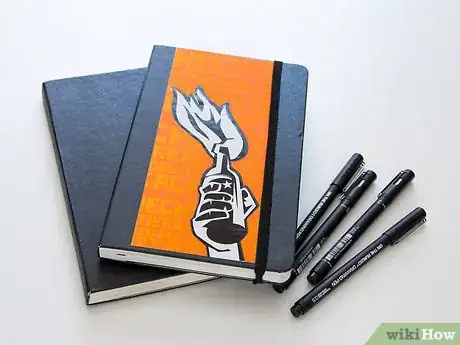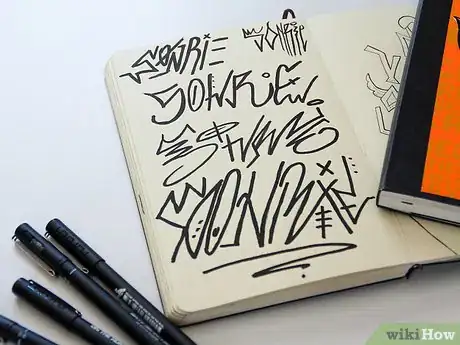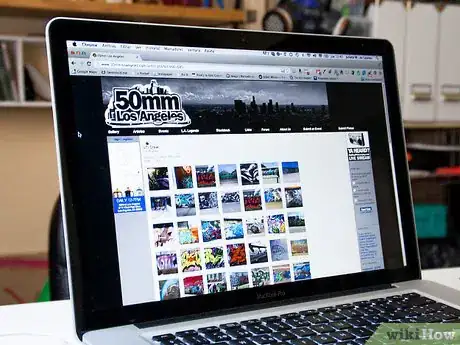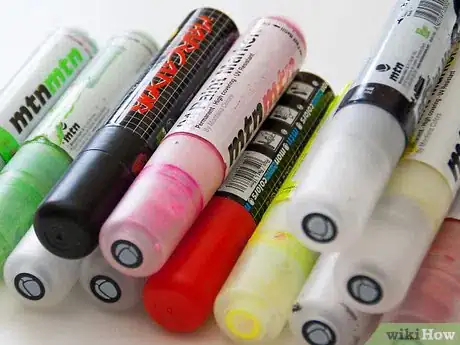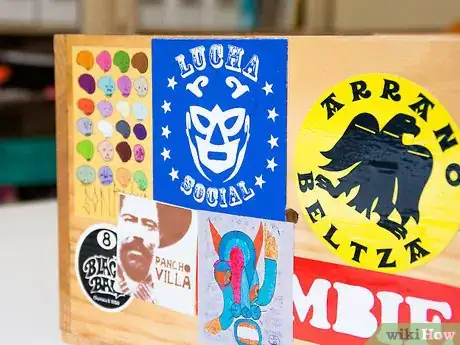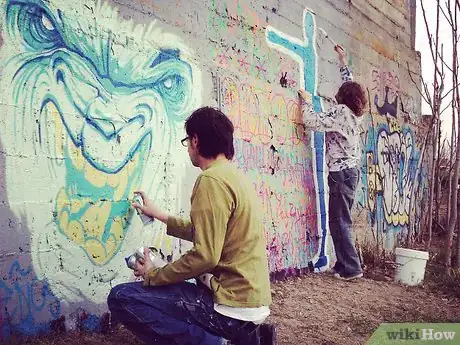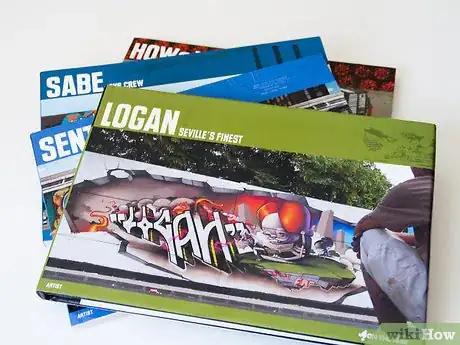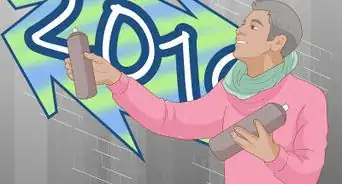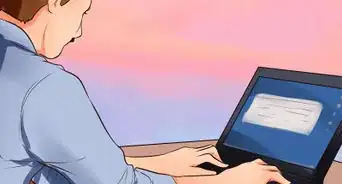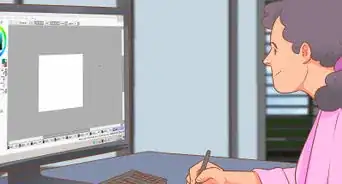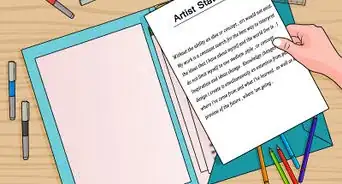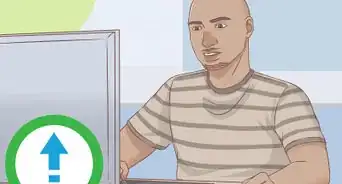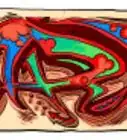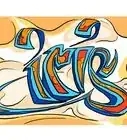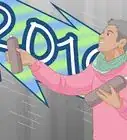This article was co-authored by Jeanine Hattas Wilson. Jeanine Hattas Wilson is a Professional Painter and the President of Hattas Public Murals, Inc. With nearly 20 years of experience, Jeanine specializes in creating, overseeing, designing, and painting murals. Jeanine holds a BA in Advertising from Marquette University and a Studio Painting Minor from The Milwaukee Institute of Art & Design. She has studied at The Atelier Artien in Paris, France, Los Angeles Academy of Figurative Art, and under renowned artists such as Robert Liberace, Michael Siegel, and William Cochran. To date, Hattas Public Murals has painted nearly 5,000 commissioned works of art in homes and commercial and public spaces.
wikiHow marks an article as reader-approved once it receives enough positive feedback. In this case, several readers have written to tell us that this article was helpful to them, earning it our reader-approved status.
This article has been viewed 509,412 times.
While graffiti is associated with vandalizing other people's property, it has slowly evolved into an art form. Now, graffiti rendered by the most talented artists commands a pretty penny and is sometimes even auctioned off. Do you have what it takes to become a graffiti artist?
Steps
-
1Go out and buy a sketchbook. Always create a sketch on your sketchbook before you try anything. If you're using an alias, try to come up with an original, interesting name. Avoid cliché names like "Ghost" or "Rage" Instead of a sketchbook, you could carry a folder or binder with paper with you.
-
2Choose a name that you would like to write and stick to it. Remember to look around for someone with the same name (words like face, ghost, king, demon, blaze, perk etc. are all common names). If you want to be really original come up with a longer word that is more cunning and perhaps relates to you or your work.Advertisement
-
3Look for inspiration in your city and on the internet, but do not directly copy anything you see; this will brand you as a toy [meaning a new artist who gets no respect] for a long time. This is also called "biting" which is a graffiti term for copying someone else's work. Biting is okay for your first graffiti piece just as long as you do not take the credit for it.[1]
-
4Evolve your style. Most people want to go straight to wild style and murals. It doesn't work out that way. Start with bubble letters and progress forward.
- Remember that real masters are always learning and evolving.
- Don't just try to come up with a gimmick and then stick with it. Instead, try different things, and try to see things in a new way.
-
5After months/weeks of practice and sketching, buy some permanent markers or make your own and begin tagging.[2]
-
6Work your way up to stickers, stencils or doing throw ups [a form of graffiti].
-
7Meet other artists of your skill and of greater skill. You can learn from your superiors in this subculture and help your equals.
-
8Do your homework. Try Researching people such as UTI CREW LOS ANGELES Researching styles can help you to understand the history of graffiti and different style.[3]
Community Q&A
-
QuestionShould this be done on a wall or paper first?
 Community AnswerFirst, get a rough sketch on paper to have an idea of what you'll do and avoid messing up on the actual wall.
Community AnswerFirst, get a rough sketch on paper to have an idea of what you'll do and avoid messing up on the actual wall. -
QuestionI need a tag name. Any suggestions?
 Community AnswerLook for something that you think defines you. If you have a general idea for a name that isn't making the cut, look for synonyms. Maybe just make up something weird that sounds cool, like way back in the day.
Community AnswerLook for something that you think defines you. If you have a general idea for a name that isn't making the cut, look for synonyms. Maybe just make up something weird that sounds cool, like way back in the day. -
QuestionWhy is graffiti illegal?
 Community AnswerGraffiti isn't illegal as long as it's not done without consent on someone's property, which is considered vandalism and is a federal crime. You're free to do graffiti on your own property or elsewhere with permission. However, many graffiti artists like the thrill of leaving graffiti in places where they're not supposed to, which is why illegal graffiti is such a common practice.
Community AnswerGraffiti isn't illegal as long as it's not done without consent on someone's property, which is considered vandalism and is a federal crime. You're free to do graffiti on your own property or elsewhere with permission. However, many graffiti artists like the thrill of leaving graffiti in places where they're not supposed to, which is why illegal graffiti is such a common practice.
Warnings
- Try to hide your identity.⧼thumbs_response⧽
- Never bring your black book when bombing.⧼thumbs_response⧽
- Never tell anyone your name or crew name.⧼thumbs_response⧽
- Never do anything that will tell other people who you are⧼thumbs_response⧽
- Stay legit, don't copy others.⧼thumbs_response⧽
- Graffiti is illegal unless you get permission from the property owner, and if you're caught, you have a huge chance of being charged.⧼thumbs_response⧽
- There is a difference between scribbling on a wall and doing art. Make sure it has some actual artistic value.⧼thumbs_response⧽
- Fumes from spray paint are highly dangerous and can kill/severely impair you. Always wear a respiratory mask.⧼thumbs_response⧽
- Graffiti is highly illegal, in many areas. If you are caught with a black book or Sharpie they may confiscate these items from you.⧼thumbs_response⧽
- Tagging places of religion, cars, public property, businesses, and people's homes is a crime and illegal.⧼thumbs_response⧽
Things You'll Need
- Plastic sheets for cutting out your tags (Stencils)
- Surface you can cut on
- X-Acto knives
- Stickers (optional)
- Spray paint
- Extra nozzles (spray paint)
- Sharpies, pens, pencils, erasers, rulers, etc.(For practicing tags/pieces)
- Paint markers or fat, permanent markers
- Black book (a graffiti artist sketch pad)
- Thick, hard cover book for you to make a hollow book out of to put stencils and the like in
- A respiratory mask for when you are spraying in small spaces
- Caps of different sizes for your cans
- Gloves
- Never wear something colorful when bombing because you may be spotted
References
About This Article
The best way to become a graffiti artist is to develop an original name and a unique style. Start small with sketching, and then start tagging with permanent markers. Develop your skill by meeting other artists and leaning the graffiti scene. For more tips and tricks on how to be a graffiti artist, including graffiti terminology, read on...
